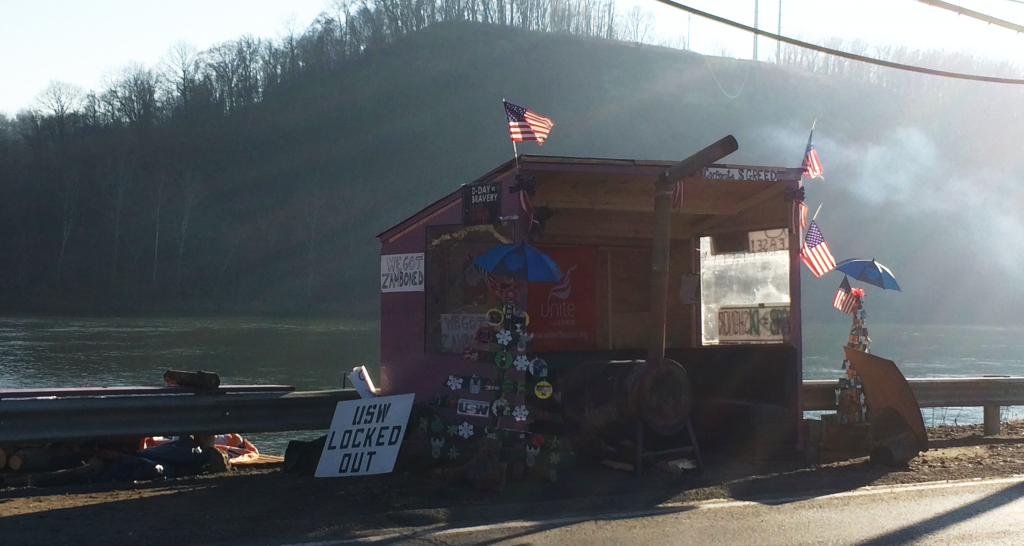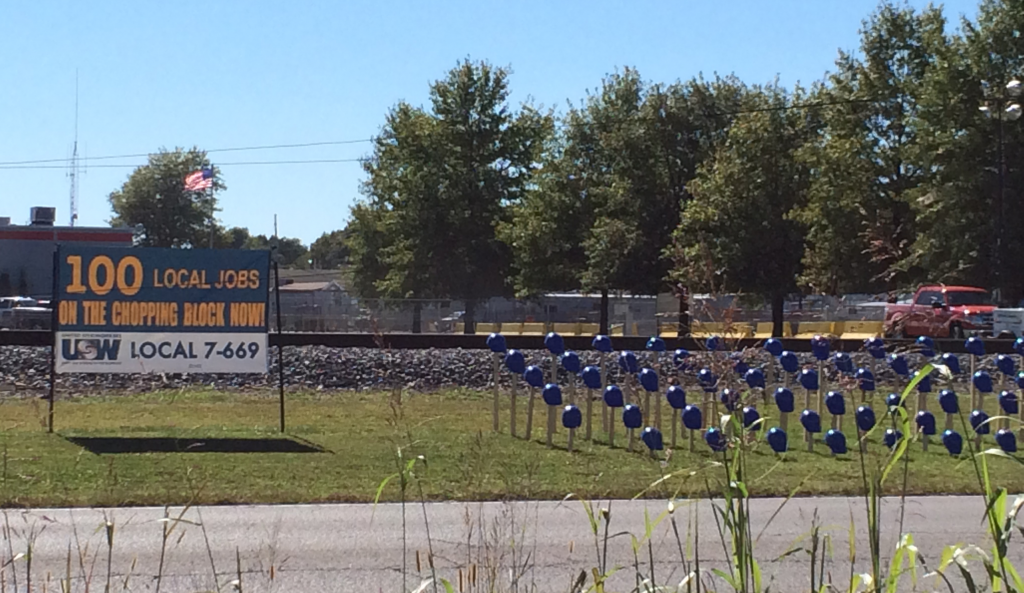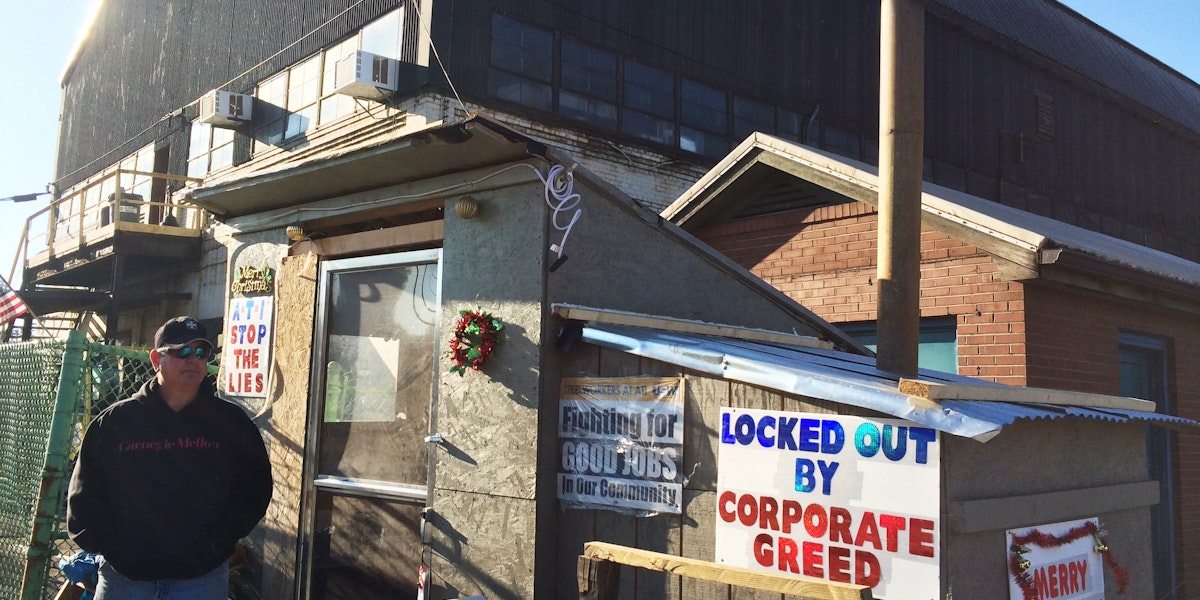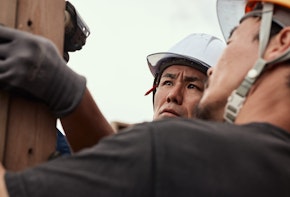“It’s a genius strategy on the part of the companies because they took our labor, which is our weapon, and they used it against us.”
—Stephen Lech, President of USW 7-669, who was locked out of the Honeywell Plant in Metropolis, IL on-and-off for approximately 1,000 days.
“In there, it’s dirty, dark, and dangerous all year round, but out here there’s no work.”
—Bill Stretsky, locked out of Allegheny Technologies in Vandergrift, PA.
On March 14, 2016, after a work stoppage that lasted almost seven months, over 2,200 steelworkers spread across six states (concentrated primarily in Western Pennsylvania) returned to work.1 If during those long winter months of the work stoppage a bystander were to pass by the Western Pennsylvania Allegheny Technology (ATI) plants in Breckenridge, Bagdad, Vandergrift, or elsewhere, he or she would have seen workers huddled in makeshift shacks, with barrel stoves trying to keep warm, and placards propped against structures that called out the CEO’s greediness. To anyone who didn’t follow the ins and outs of labor relations in the region, it would have looked like these workers were out on strike. But these picketing workers were not out in the cold of their own accord; they were being locked out by their employer.
The labor lockout—an action by the management of a company to deny workers access to their place of employment—was once a rare phenomenon compared to the strike, and there was a time when one could be fairly certain that any work stoppage was a strike. But in recent years, the federal courts and the National Labor Relations Board (NLRB) have expanded the permissible use of lockouts by management to the point that they now represent a significant portion of work stoppages. At a time when the most well-known tools of labor organizing have already been undermined by aggressive (and too frequently unlawful) anti-union tactics by employers,2 this enhancement of management power is designed to weaken the bargaining power of unions, and lead to a further decline in the earnings and benefits available to hard-working families. The previous rationale for widely authorizing the use of employer lockouts is outdated in today’s economy. In order to properly balance the interest of employers and workers, and preserve workers’ rights to organize, bargain, and strike, the courts should reconsider their precedents and take decisive action to curtail lockouts.
This report will examine the current state of lockouts, how they have increased in relation to strikes, how the law has permitted this expansion, and what must be done to restore workers’ rights to stop work.
What Is a Labor Lockout?
A lockout is what it sounds like: “a temporary withholding or denial of employment during a labor dispute in order to enforce terms of employment upon a group of employees. A lockout is initiated by the management of an establishment.”3 The past few decades have seen a precipitous decrease in strikes, but lockouts have experienced only a slight decline, such that lockouts now constitute a significant portion of all work stoppages.
In some senses, strikes and lockouts represent two sides of the same coin. Supreme Court Justice Arthur Goldberg (who had previously served as the General Counsel for the United Steelworkers (USW) and U.S. Secretary of Labor) lumped them together when he wrote in one of the seminal cases concerning the labor lockout, “[w]hen we deal with the lockout and the strike, we are dealing with weapons of industrial warfare.”4 In a strike the employees refuse to work; by contrast, in a lockout, the employer refuses to allow the employees to work. Labor law has developed to permit the labor lockout, with the primary difference being that an employer may hire permanent replacement workers during a strike, but may only hire temporary replacements during a lockout.5 The increase in the proportion of work stoppages that are lockouts is indicative not only of a general decrease in labor’s power, but also represents a real threat to the unions and industries where lockouts are most common.
Work stoppages are powerful tools, and this shift toward the lockout represents management’s co-optation of one of labor’s strongest economic weapons—yet another example of how the workplace is increasingly being skewed in favor of employers. With even just the threat of a lockout in its hand, management can ensure that almost any union organizing effort would fail to gain traction. Allowing employers to throttle organizing among workers in this manner is dooming employees to the losing side of the table.

The lockout is more than simply a complement to the strike. An employer need not lock out the union when the collective bargaining agreement expires—indeed, in many instances workers continue to work under the expired contract for months or years until a new contract is signed. Employers lock out workers for the purpose of putting pressure on them to gain significant concessions in the workplace. Allowing employers to engage in labor lockouts diminishes the workers’ right to strike, which should be studiously protected under labor law. Employers have almost every advantage in the workplace, and the one area where workers should be in control is in the questions of whether and when to withhold their labor.
The timing of a work stoppage is of prime importance, as it can either put maximum pressure on the workers or the employers. For instance, strikes are often held during the employer’s “busy season,” when the employer will have the greatest incentives to keep the work stoppage short. Conversely, employers often lock out workers when they have the least demand for labor and believe they can force concessions from the union. This decision of who controls the timing and fact of a work stoppage revolves around power, and as labor’s power wanes, lockouts have constituted an ever greater proportion of all work stoppages.
Analysis of all work stoppages from 2010-14 reveals that the vast majority of recent lockouts occur in three industries: manufacturing; arts, entertainment, and recreation; and utilities.6 These three industries account for approximately 70 percent of all lockouts during this four-year period. Similarly, lockouts clustered around a few unions. The United Steelworkers and the International Brotherhood of Teamsters each experienced approximately 20 percent of all lockouts, while musicians’ unions combined experienced almost 10 percent of all lockouts. These industries are particularly susceptible each for their own unique reasons, but one factor they all share is a high and low season, making the timing of the work stoppage extremely important. Furthermore, despite these sectors rebounding and adding significantly more jobs since the Great Recession, unions representing such workers have continued to lose membership. Lockouts place additional strain on the unions, and in many instances, employers have been explicit that this is one of the goals of the lockout.7
Striking workers have made a collective choice to withhold their labor for a period of time in order to achieve their goals, but locked-out workers exist in a sort of limbo. Without recourse to withholding their labor as an economic weapon, the workers have to play a waiting game. They wait for the company to decide that replacements and labor uncertainty are not economically feasible; they wait for the public to rally behind them and declare that locking out a worker is wrong; and they wait for the National Labor Relations Board (NLRB) to hopefully issue a complaint alleging that the lockout is illegal.
“Mentally, you just really don’t care no more. Financially, you never can get ready for it. You never can recover enough money. You never know what’s going to happen. All you can do is to try to be ready for it. They taught me how to live with nothing.”
When asked how a worker can prepare for a lockout, one worker who had lived through several lockouts responded: “Mentally, you just really don’t care no more. Financially, you never can get ready for it. You never can recover enough money. You never know what’s going to happen. All you can do is to try to be ready for it. They taught me how to live with nothing.”8
Work Stoppages—Decline of the Strike, Use of the Lockout
Determining the exact number of lockouts in a given year or over time is difficult, because the Department of Labor (DOL) has for several decades collected only an abridged form of such data. In 1982, Ronald Reagan’s DOL announced that “due to budget stringencies,” it would cease collecting data on all work stoppages involving at least six workers, and instead only collect data on work stoppages involving over 1,000 workers.9 This change in definitions and collection of data had profound effects on the official number of work stoppages—both strikes and lockouts. Researchers who reviewed the results in the change of definition of work stoppages found that if the new definition were retroactively applied to all work stoppages between 1947-1981, the number of total work stoppages falls from 4,378 to 296.10 Even at the time of these proposed changes, there was outcry that Reagan’s “budget stringency” reforms that were going into effect would result in “dry rot,” “invented data,” and “the production of horror stories.”11
The results of government reductions in data collection in a variety of areas have been well-documented, such as Congress’s ban on the Center for Disease Control performing research on gun violence.12 Similar concerns apply to this area. In addition to not having detailed data on the locations, industries, durations, number of workers involved, issues at stake, and other matters for research purposes, one is also left to make problematic assumptions on work stoppages based on the largest strikes and lockouts. And research has shown that using data from large work stoppages and attempting to make generalizations about all work stoppages from that data is flawed because large strikes have unique characterizations that are not generalizable.13
Without any detailed statistics and data from the Bureau of Labor Statistics, one is forced to piece together lists of lockouts, industries involved, the number of workers, and other data from a hodgepodge of sources such as the Federal Mediation and Conciliation Service (FMCS), Freedom of Information Act requests to the NLRB, Current Population Surveys, BNA Reports, newspapers, press releases, interviews, and other such sources. The data in this report has been compiled using these sources.
Many lockouts go unreported. The lockouts consist of less than 1,000 workers, and are therefore not included in BLS data collection nor often covered by the media. The lockouts that have garnered the most attention have been the high profile sports lockouts. Indeed, in the course of less than two years in 2011-12, three major sports leagues in the United States locked out their players for significant lengths of time: in 2011, the National Football League (NFL) lockout out players for 136 days and the National Basketball Association (NBA) locked out players for 161 days. The following year, the National Hockey League (NHL) locked out players for 119 days.14
Though professional sports generally represent a problematic lens with which to view labor—due to the high pay, individualized contracts, and unique circumstances of the industry—major sports work stoppages illustrate the importance of controlling the timing of a work stoppage. In 1994, baseball players instituted a strike against Major League Baseball (MLB) on August 12. This was late in the season, when interest is highest among sports fans, with the purpose of putting pressure on the owners. In contrast, each of the lockouts that occurred in 2011–12 were in the pre-season, when the owners have less at stake and lose much less economically.15
…Lockouts occur well beyond the professional sports context; and while strikes have been on a steep decline over the past several decades, lockouts have only moderately declined, making them now a significant percentage of all work stoppages.
However, lockouts occur well beyond the professional sports context; and while strikes have been on a steep decline over the past several decades, lockouts have only moderately declined, making them a significant percentage of all work stoppages now. Based upon data collected by the author, Figure 1 shows the number of work stoppages for each year from 1990 to 2015. In 1990, there were 833 work stoppages, and this number has steadily declined, to where there were only eighty-five total work stoppages in 2015, representing a 90 percent decline. This decline has been relatively steady, with almost each year experiencing a 5 to 20 percent decline in work stoppages.
Work stoppages in America have reached historically low levels, and although unions rarely resort to strikes, employers have not similarly abandoned the lockout. While the number of lockouts have declined, from thirty-two in 1990 to thirteen in 2015, this decline has been much more moderate than the decline in strikes, leading to an increase in proportion of lockouts to total work stoppages. In 1990, lockouts represented less than 4 percent of total work stoppages, whereas in 2015 lockouts represented over 10 percent of total work stoppages (Figure 2). This is particularly pronounced in several key industries, manufacturing being the leader by far. One manufacturing worker who was locked out of the Honeywell Plant in Metropolis, IL, described how “lockouts have just become a fact of life.” She explained that at each contract renewal there was a chance that the employer would lock the workers out. Whereas most workers talk about the time left until retirement in terms of their pensions or plans, she measured that time in terms of how many more lockouts she may have to endure. “Isn’t that sad? But you know what, I got one more lockout to go. I told my daughter, depending on when the contract comes back and how long it is. You go four years, and after four years I get locked out again. I said I got one more lockout to go. That’s how I look at it.”16
The data for these charts were compiled using newspaper articles, BLS data, FMCS data, NLRB FOIA requests, BNA data, and press releases found online.
Two of the industries—manufacturing and utilities—that have experienced the greatest number of lockouts have experienced significant growth since the Great Recession. Employment in utilities has increased by 14 percent since 2012, which brings its employment figures to its highest level since 2000. Similarly, manufacturing employment has increased from a 2010 low of 13.2 million workers to 14.5 million in 2015, representing an almost 10 percent increase. However, despite these growths in employment, both industries have experienced declines in the number of workers represented by unions, with utilities declining 6 percent since 2012 and manufacturing declining 5 percent since 2010.17
These figures show particular vulnerability among unions representing workers from these sectors. Not only are the unions not representing many of the workers in the new jobs being created, but they are losing members from traditionally union jobs. Lockouts present employers in the sectors the opportunity to seek significant concessions from labor. As one executive at ATI told the New York Times during the lockout, “We’re faced with a once-in-a-generation opportunity to bend the cost curve on a major part of our costs,” he said. “If we’re going to be competitive, we have to be in a position where we have a different benefit structure for the next generation we hire.”18
In contrast to these figures, the health care sector—which experienced the greatest number of strikes—has had consistent increases in employment, with 12 million workers in 2000 and 17 million in 2015. Union membership has largely tracked this increase, with 1 million members in 2000 and 1.4 million in 2015.19
In trying to extract greater concessions from workers, data analyzed for this report show that lockouts tend to last considerably longer than strikes. Between 2010 and 2014, the average strike lasted approximately thirty-five days, while the average lockout lasted approximately 147 days.
Law of the Lockout
The employer’s right to lockout workers is largely a judge-created doctrine. In the late nineteenth and early twentieth century, lockouts were permitted under common law.20 Senator Robert Wagner’s original 1934 version of the National Labor Relations Act declared prominently in Section 8(1) that it was an unfair labor practice “to attempt, by interference, influence, restraint, favor, coercion, or lockout, or by any other means, to impair the right of employees granted in Section 4.”21 Business interests strongly objected to the prohibition on lockouts. A representative from the business group, the American Mining Congress, was flabbergasted that the bill protected workers, but did not similarly protect “the employer, his property or his business.”22 Similarly, a representative of the anti-union National Association of Manufacturers testified that “we condemn unrestricted strikes just as we condemn lockout[s]. They deserve to join in limbo the blacklist and the boycott.”23 Following this criticism from business interests, the reference to lockouts was removed in Committee, and not included in the National Labor Relations Act(NLRA) of 1935.24 When the Taft-Hartley Act amended the NLRA in 1947, it did not explicitly permit lockouts, but it regulated them by stating that neither the employer nor the union could resort to a “strike or lockout” without meeting certain procedural conditions.25 Courts investigating whether lockouts are permitted have interpreted this regulation as “a recognition of the legitimacy of the device as a means of applying economic pressure in support of bargaining positions.”26
The federal courts and NLRB allowance of lockouts and replacement workers developed over time to allow them first in defensive instances, then in offensive instances, and then with the use of replacement workers. This broad allowance by the NLRB and courts has gone significantly past the intent of the law, and should be reconsidered.
In 1957, the Supreme Court in NLRB v. Truck Drivers Local Union No. 449 (“Buffalo Linen”) held that defensive lockouts by an employer in a multiemployer bargaining group were permitted.27 The case grew out of a group of employers using lockouts in response to a whipsaw strike, which occurs when a union strikes each employer in a multiemployer bargaining group successively. Such strikes were effective because employers would have to settle the matter quickly out of fear of losing business to competitors that were not subject to the strike. The Board held that the strike against one employer in the group “carried with it an implicit threat of future strike action,” and the Court agreed that the defensive use of a lockout was permitted in such a situation.28 The Court made clear that it saw the lockout as a permissible means for small employers to defensively preserve multi-employer bargaining, which had existed long before the Wagner Act’s passage.29 Without evidence of anti-union motivations for the lockout, the Court upheld the legality of the lockout. However, the Court made clear that the lockout was permissible because a strike was imminent. Courts have moved far beyond this level of inquiry and have come to permit lockouts in almost any situation where the union cannot prove anti-union motivations.

Eight years later, in American Ship Building Co. v. NLRB, the Supreme Court answered a question left open in Buffalo Linen of whether an employer is permitted to engage in an offensive lockout of workers in order to put pressure on workers during a labor dispute.30 This case involved an employer that operated a seasonal business, which meant that controlling the timing of a work stoppage was of utmost importance. The Supreme Court rejected the previous distinction between offensive and defensive lockouts, and found that a lockout did not constitute an unfair labor practice.31 The NLRB argued unsuccessfully that lockouts violated the NLRA because they interfered with workers’ rights to strike and bargain collectively. The NLRB also argued that the “use of the lockout ‘punishes’ employees for the presentation of and adherence to demands made by their bargaining representatives and so coerces them in the exercise of their right to bargain collectively.”32 However, the Supreme Court held that while it is “true that recognition of the lockout deprives the union of exclusive control of the timing and duration of work stoppages calculated to influence the result of collective bargaining negotiations, … there is nothing in the statute which would imply that the right to strike ‘carries with it’ the right exclusively to determine the timing and duration of all work stoppages.”33
This statement set a dangerous precedent because it sanctioned the idea of locking out workers for refusing to sign a contract that they believe is unfair. It allowed employers to simultaneously hold the position that they were not acting in an anti-union fashion while locking out workers who were willing to continue working, on the sole basis that they engaged in union activities.
Another major shift occurred under Reagan’s Labor Board in a case called Harter Equipment Inc., when the Board changed its previous position and upheld the use of temporary replacement workers during an offensive lockout.34 The Labor Board, which sets labor policy and received considerable deference from the courts, now held that the lockout was a full complement to the strike. The allowance of replacement workers made the lockout a powerful economic weapon because it permitted employers to run on non-union labor until such time as the workers conceded any demands.
In Harter Equipment, the employer locked out workers during contract negotiations in order to put pressure on the union. The Board held that
“The use of temporary employees here had only a comparatively slight effect on employee rights. As in Brown Food Store, we do not see how the employer’s operation with temporary replacements implies hostile motivation any more than the lawful lockout itself; nor do we see how any effort to remain in operation after a lawful lockout could be “inherently destructive” of employee rights and per se violative of the Act without inquiry into the employer’s motivation. The fact that the Respondent here was the protagonist in locking out employees does not warrant inferring any greater impact on employee rights from the subsequent use of temporary employees.”35
The Board established a problematic dichotomy by asking if a lockout was “inherently destructive” of employees’ rights or “comparatively slight.” In describing the meaning of “inherently destructive,” the Board set an exceptionally high bar, and made it clear that an employer dooming a strike to failure or taking away any meaningful right to strike from workers was not “inherently destructive.”36
The Board concluded “that using temporary employees after a lawful lockout in order to bring economic pressure to bear in support of legitimate bargaining demands (1) is a measure reasonably adapted to the achievement of a legitimate employer interest and (2) has only a comparatively slight adverse effect on protected employee rights.”37Harter Equipment put the burden on the Board to prove that the lockout and use of replacement workers was the result of the employer’s anti-union animus. If it failed to make such a showing, the lockout would be legal.38 The Board held that “apart from this category of exceptional cases” where a lockout was “inherently destructive” of workers’ rights, the lockout and use of temporary replacements was entirely legitimate.
As a result of this expanding allowance of lockouts and replacement workers, the NLRB has issued relatively few complaints against employers who institute lockouts. Freedom of Information Act requests reveal that the NLRB has only issued twenty-six complaints from 2007-2014 against employers, whereas during that same period there were ninety-three lockouts. This means that the NLRB found there to be sufficient evidence in only 28 percent of lockouts that the employer has violated the law. This is because both offensive and defensive lockouts—with the use of temporary replacement workers—have been found to be permitted under the NLRA. It is only when an employer combines the lockout with other anti-union activities that it finds itself afoul of the law.39
The Locked Out Workers40
In some respects, lockouts are better financially for workers than strikes because striking workers are generally not permitted to collect unemployment compensation benefits.41 In contrast, many states have statutorily or judicially determined that locked out workers are eligible for such unemployment benefits.42 These benefits vary widely by state. They provide a portion of a worker’s pay (ranging from a maximum of $235/week in Mississippi to $943/week for an individual with dependents in Massachusetts) for a limited time (ranging from a maximum of six weeks for some workers in Georgia to thirty weeks in some circumstances in Massachusetts).43
“Do I cry? Yeah. Do I have the time when I wonder if I’m going to make it? Yes.”
Though these amounts are usually far too low to sustain workers during work stoppages, they do provide a lifeline so that workers can pay for some of the essentials. Furthermore, locked out workers often lose their employer-sponsored health insurance early in the lockout. Some are able to get replacement insurance from a spouse, and some utilize “catastrophic” health insurance offered by the union, “and just try not to get sick or hurt.” It is often difficult to find temporary work during a lockout because there is suddenly a glut of similar workers searching for temporary work. Locked out workers have described the psychological toll of living with such extreme economic and employment insecurity, not being able to provide for their families, and not knowing if and when they will be able to return to work. One locked out worker in Illinois whose benefits had run out explained that every day is a struggle. “Do I cry? Yeah. Do I have the time when I wonder if I’m going to make it? Yes.”

The unemployment benefits workers receive are helpful, but they may also represent a double-edged sword. Whereas in a strike, the workers and the employers feel the complete pain of a work stoppage immediately, in a lockout some of the financial strains on the workers are mitigated for a period of time. Employers understand this reality, and try to extend lockouts beyond the point of when their unemployment benefits run, so that the workers will be forced to accept all concessions and return to work. Stephen Lech, the president of USW 7-669, who was locked out of the Honeywell Plant in Metropolis, IL for approximately 1,000 days between 2010-2015, explained that:
“The problem with a lockout—or any labor dispute—is that it’s like an algorithm. In the beginning of the lockout, their expenses go up and their production goes down. The longer that the lockout goes, the closer those lines come together: expenses come down; production comes up. So there comes a point where they can last forever. …There comes a point where they’re in a position to go forever, so you have to make a decision on whether you live to fight another day. Do you change your definition of what a win would be.”
In addition to the financial strains of lockouts, there is the problem of uncertainty in future work-related matters. Locked-out workers often do not know if and when they will be able to return to work, they do not know the employer’s true motivations for locking them out, and they do not know if the employer is faring fine without them. At the picket line in Vandergrift, PA during the ATI lockout, workers would discuss how many truckloads or trainloads of rolled steel they saw leaving the plant, in order to get a sense of what level of capacity the employer was functioning at. One locked out worker explained that “there’s a lot we don’t know right now, but we know when they’re running and when they’re rolling.” Another explained that he watches the smokestacks, because “if you don’t see heat waves from the smokestacks, it means they’re not working.” Similarly, they would try to count the number of buses and passengers of replacement workers being driven in and out of the plant. Rumors abound on every aspect of the lockout, and workers are often left in the dark.
Conclusion
On May 31, 2016, the NLRB released an important decision that limited the employer’s use of replacement workers during a strike.44 The Board held that the employer’s motivation in hiring replacement workers is important, and if the decision is made to discourage union membership, then the use of replacement strikers is a violation of the Act. Harvard Law Professor Ben Sachs argued that the decision brought “some sanity” to the use of replacement strikers because it addressed the long-standing tension in the law where workers may not be fired for striking, but they may be permanently replaced.45 It is time for the NLRB to similarly bring some sanity to the use of lockouts and temporary replacement workers.
Lockouts are highly disruptive of workers’ lives and they impact one of labor’s greatest strengths: its ability to strike.
Lockouts are highly disruptive of workers’ lives and they impact one of labor’s greatest strengths: its ability to strike. The lockout serves as a looming threat and a punishment for workers who have joined a union and engaged in meaningful collective bargaining. The employer’s right to lay off all union workers—even if only temporarily—because they engage in their rights to collectively bargain violates these workers’ core rights.
As labor lockouts continue to rise as a percentage of work stoppages, the National Labor Relations Board should reconsider its position that lockouts do not have much impact. In following the Supreme Court’s direction, the NLRB should investigate whether the lockout has had on a “slight effect on employee rights.”
If one walks the picket line in a lockout, one can easily conclude that the effects on workers’ rights are significant. The balance of power is already greatly tilted towards employers, and the right to withhold labor should belong solely to workers. Putting this power to stop work primarily back in the hands of workers is one step toward leveling the playing field of labor.
Notes
- “USW Reaches Deal to End ATI Lockout,” Nwlaborpress.org, March 1, 2016, https://nwlaborpress.org/2016/03/usw-ati/. ATI workers were locked out in the company’s Flat Rolled Products division at 12 plants in Pennsylvania, Ohio, Oregon, Massachusetts, Connecticut, and New York.
- Mark Zuckerman, Richard Kahlenberg, and Moshe Marvit, “Virtual Labor Organizing,” The Century Foundation, June 9, 2015, https://tcf.org/content/report/virtual-labor-organizing/.
- Bureau of Labor Statistics, FAQ, http://www.bls.gov/wsp/wspfaq.htm#Question_3
- American Ship Bldg. Co. v. NLRB, 380 U.S. 300, 338 (1965) (Goldberg concurring).
- See NLRB v. Mackay Radio & Telegraph Co., 304 U.S. 333 (1938), and Harter Equipment Inc., 280 NLRB 597 (1986).
- The data for this report has been collected from the Federal Mediation and Conciliation Service, Freedom of Information Act requests to the National Labor Relations Board, Current Population Surveys, BNA Reports, newspapers, press releases, interviews, and other such sources.
- Steven Greenhouse, “In Pennsylvania, a Steel Mill and Its Workers at a Crossroads,” New York Times, December 3, 2015, http://www.nytimes.com/2015/12/04/business/in-pennsylvania-a-steel-mill-and-its-workers-at-a-crossroads.html.
- Interview with worker locked out of Honeywell plant in Metropolis, IL. Paducah, KY (09/23/2014).
- L.J. Perry and Patrick Wilson, “Trends in Work Stoppages: A Global Perspective, International Labour Organization,” International Labour Office Working Paper 47 (2004): 10.
- Ibid.
- Martin H. David, Statement on the Future of Federal Statistics before the Sub-Committee on Census and the Post Office, March 16, 1982. See also Caroluyn Shaw Bell, The Erosion of Federal Statistics, Challenge, Vol. 26, No. 1 (March/April 1983).
- Erin Schumaker, “Why the Ban on Gun Violence is a Public Health Issue,” The Huffington Post, December 7, 2015, http://www.huffingtonpost.com/entry/dickey-amendment-gun-violence-research-ban_us_56606201e4b072e9d1c4eaaa; Natasha Bertrand and Brett LoGiurato, “A Nearly 20-Year-Old Ban is Preventing Huge Government Agency from Researching Gun Violence,” Business Insider, December 4, 2015, http://www.businessinsider.com/congressional-ban-on-gun-violence-research-2015-11; German Lopez, “What Forms of Gun Control Work Best? Congress Bans Federal Agencies from Finding out,” Vox, December 10, 2015, http://dare-think.com/2015/12/what-forms-of-gun-control-work-best-congress-bans-federal-agencies-from-finding-out/.
- Jack W. Skeels, Paul McGrath, Gangadha Arshanapalli, “The Importance of Strike Size in Strike Research,” Industrial and Labor Relations Review, Vol. 41, No. 4 (Jul. 1988).
- “Pro Sports Lockouts and Strikes Fast Facts,” CNN, May 4, 2016, http://www.cnn.com/2013/09/03/us/pro-sports-lockouts-and-strikes-fast-facts/.
- The NHL lockout began on September 15, 2012, and the season usually begins in mid-October; the NBA lockout began on July 1, 2011, and the season usually begins in late October; and the NFL lockout began on March 12, 2011, and the season usually begins in September.
- Interview with worker locked out of Honeywell plant in Metropolis, IL. Paducah, KY (09/23/2014).
- Data from Current Population Survey and LM-2 labor organization annual reports filed with the Department of Labor.
- Steven Greenhouse, “In Pennsylvania, a Steel Mill and Its Workers at a Crossroads,” New York Times, December 3, 2015, http://www.nytimes.com/2015/12/04/business/in-pennsylvania-a-steel-mill-and-its-workers-at-a-crossroads.html.
- Data from Current Population Survey and LM-2 labor organization annual reports filed with the Department of Labor.
- Thomas S. Cogley, The Law of Strikes, Lockouts and Labor Organizations, W.H. Lowdermilk & Co. (Washington D.C.: 1894). See Also Iron Molders’ Union No. 125 of Milwaukee, Wis. v. Allis-Chalmers Co., 166 F. 45, 50 (7th Cir. 1908) (” For instance, employers may lock out (or threaten to lock out) employees at will, with the idea that idleness will force them to accept lower wages or more onerous conditions; and employees at will may strike (or threaten to strike), with the idea that idleness of the capital involved will force employers to grant better terms.”)
- 1 Legislative History of the National Labor Relations Act, 1935, 3. Section 4 of the bill is what became Section 7. It provided:
“Employees shall have the right to organize and join labor organizations, and to engage in concerted activities, either in labor organizations or otherwise, for the purposes of organizing and bargaining collectively through representatives of their own choosing or for other purposes of mutual aid or protection.” Ibid. - Ibid at 946.
- Ibid at 406.
- See e.g. Statement of N.W. Pickering, President of Farrell Birmingham Co., and the Lower Naugatuck Valley Industrial Assn., To Create a National Labor Labor Board Hearings on S.2926 Before Senate Comm. On Educ. And Labor, 73d Cong., 2d Sess. 511 (1934) (“I shall not attempt to attack in detail the many undesirable features of the bill under discussion. These have unquestionably been brought to your attention. Suffice it to say, that ‘equalize’ is used in the explanation of purpose of the proposed act. Can this word be substantiated when labor is allowed to ‘strike’ but employers are not allowed to employ, in turn, the ‘lock-out’? That is not ‘equity.’”)
- 29 U.S.C. § 158(d)(4).
- American Ship Bldg. Co. v. NLRB, 380 U.S. 300, 315 (1965).
- NLRB v. Truck Drivers Local Union No. 449, International Brotherhood of Teamsters (“Buffalo Linen”), 77 S.Ct. 643 (1957).
- Buffalo Linen, 77 S.Ct. at 645.
- Ibid. at 647.
- American Ship Building Co. v. NLRB, 380 U.S. 300 (1965).
- Ibid.
- Ibid, at 308-309.
- Ibid. at 310.
- Harter Equipment Inc., 280 NLRB 597 (1986), aff’d Local 825, International Union of Operating Engineers v. NLRB, 829 F.2d 458 (3rd Cir. 1987).
- Ibid at 599-600.
- Ibid at 598.
- Ibid at 600.
- Ibid. at 598-599.
- Often these replacement workers can make far more than the locked out workers. See Len Boselovic, “ATI Pay—for Workers, Executives—Stokes Anger, Raises Questions,” Pittsburgh Post-Gazette, September 23, 2015, http://www.post-gazette.com/business/career-workplace/2015/09/13/Len-Boselovic-s-Heard-Off-the-Street-Advertised-pay-for-ATI-replacement-workers-raises-questions/stories/201509300010.
- Much of this section is derived from interviews with locked out workers in Illinois and Pennsylvania in 2014 and 2016.
- Mark A. Rothstein, Charles B. Craver, Elinor P. Schroeder, Elaine W. Shoben, Employment Law § 10.14, at 872-73 (3d ed. Thomson-West).
- Douglas E. Ray, William R. Corbett and Christopher David Ruiz Cameron, Labor-Mgmt Rel: Strikes, Lockouts and Boycotts § 9:10 (Database updated September 2015).
- Department of Labor Employment and Training Administration, “Comparison of State Unemployment Laws,” (available at: http://workforcesecurity.doleta.gov/unemploy/comparison2014.asp)
- American Baptist Homes, 364 NLRB No. 13 (May 31, 2016).
- Benjamin Sachs, “Some Sanity on Striker Replacements,” On Labor, June 1, 2016, https://onlabor.org/2016/06/01/some-sanity-on-striker-replacements/#more-14467










